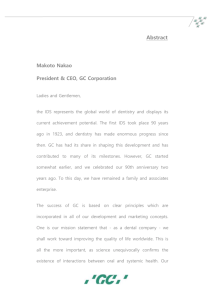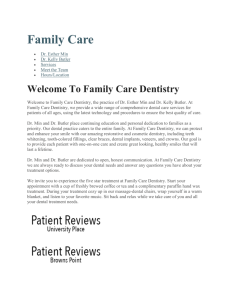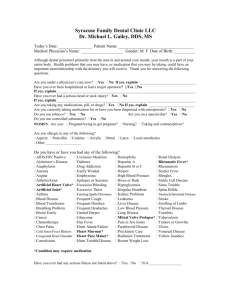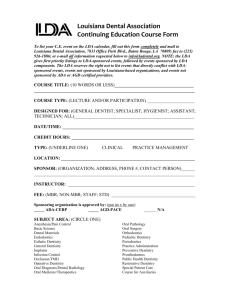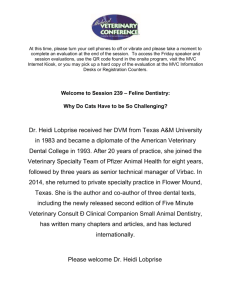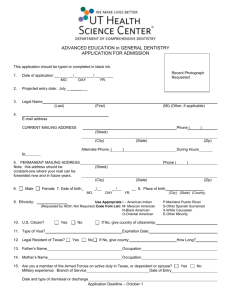Perfection in Dentistry. World Leaders` Aims and Achievements
advertisement
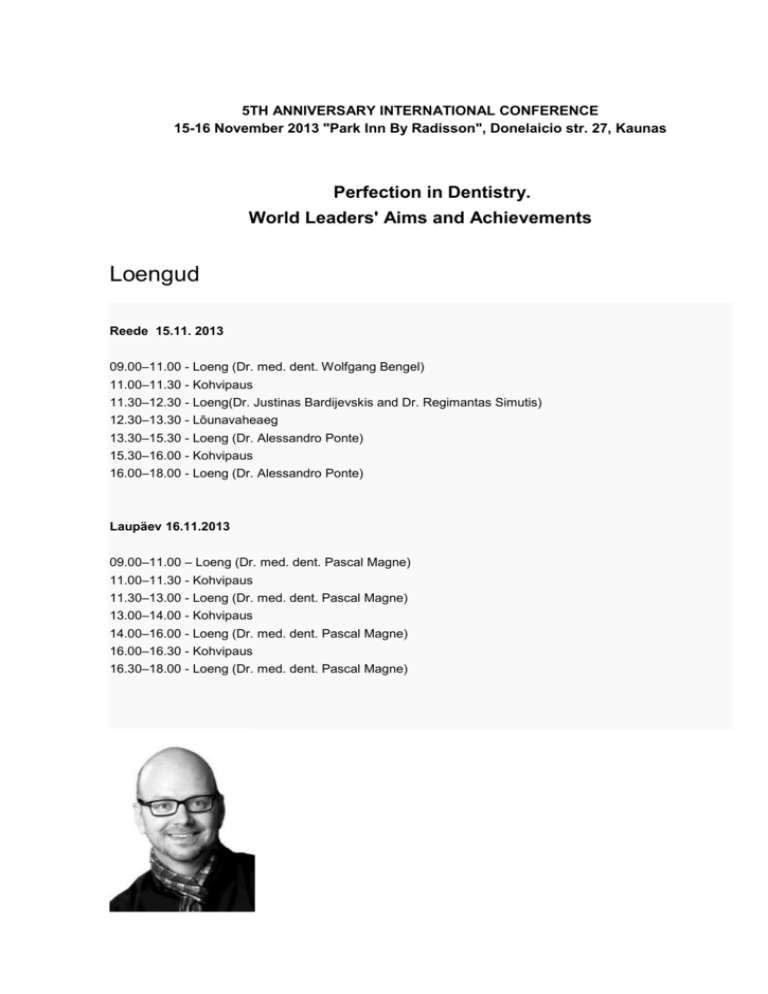
5TH ANNIVERSARY INTERNATIONAL CONFERENCE 15-16 November 2013 "Park Inn By Radisson", Donelaicio str. 27, Kaunas Perfection in Dentistry. World Leaders' Aims and Achievements Loengud Reede 15.11. 2013 09.00–11.00 - Loeng (Dr. med. dent. Wolfgang Bengel) 11.00–11.30 - Kohvipaus 11.30–12.30 - Loeng(Dr. Justinas Bardijevskis and Dr. Regimantas Simutis) 12.30–13.30 - Lõunavaheaeg 13.30–15.30 - Loeng (Dr. Alessandro Ponte) 15.30–16.00 - Kohvipaus 16.00–18.00 - Loeng (Dr. Alessandro Ponte) Laupäev 16.11.2013 09.00–11.00 – Loeng (Dr. med. dent. Pascal Magne) 11.00–11.30 - Kohvipaus 11.30–13.00 - Loeng (Dr. med. dent. Pascal Magne) 13.00–14.00 - Kohvipaus 14.00–16.00 - Loeng (Dr. med. dent. Pascal Magne) 16.00–16.30 - Kohvipaus 16.30–18.00 - Loeng (Dr. med. dent. Pascal Magne) Dr. med. dent. Pascal Magne (Switzerland) Bonded restorations in the anterior dentition 1989 "Diplôme fédéral de médecin-dentiste" (DMD), University of Geneva Dental School, Switzerland. 1990 "Doctorat en médecine dentaire" (MSc), University of Geneva Dental School, Switzerland. 2002-2008 "Privatdocent, University of Geneva Dental School, Switzerland. 1989-1997 Lecturer at the University of Geneva Dental School" Division of Operative Dentistry & Endodontics (Prof. Jacques HOLZ). Division of Fixed Prosthodontics (Prof. Urs BELSER)1992- 1995 Academic activity (above) combined to part time private practice. 1997-1999 Visiting Associate Professor at the Minnesota Dental Research Center for Biomaterials and Biomechanics (Prof. William H. Douglas), University of Minnesota, School of Dentistry, USA, supported by the Swiss Science Foundation, Grant 81GE-50071 and the Swiss Foundation for Medical-biological Grants. 1999-2004 Senior Lecturer at the University of Geneva Dental School, Division of Fixed Prosthodontics (Prof. Urs BELSER). Since February 2004 Tenured Associate Professor and Don and Sybil Harrington Foundation Chair in Esthetic Dentistry, University of Southern California School of Dentistry, Los Angeles. The combination of both composites and ceramics seems theoretically appropriate to reproduce the original stiffness of the tooth and modulate the tooth-restoration strength. Therefore, modern concepts in restorative dentistry have brought new solutions through bonded porcelain restorations (BPRs) that are stress distributors and involve the crown of the tooth as a whole in supporting occlusal force and masticatory function. Among these, the good overall clinical behavior of anterior porcelain laminate veneers bonded tooth in terms of fracture rates, microleakage, debonding and soft tissue response is generally well recognized and attested by numerous clinical studies. Continuous developments in the field of adhesive restorative techniques have permitted significant broadening of the originally-defined spectrum of indications for BPRs in the anterior dentition and thus contribute to two of the major objectives of conservative restorative dentistry: the maximum preservation of sound tooth structure and the maintenance of the vitality of the teeth to be restored. Indications for BPRs are extending to more perilous situations (worn-down, nonvital or crownfractured teeth), resulting in considerable improvements, comprising both the medicalbiological aspect and the socio-economical context (ie, decrease of costs when compared to traditional and more invasive prosthetic treatments). From this perspective, indications, treatment planning, diagnostics, tooth preparation, laboratory procedures and adhesive luting procedures of BPRs will be carefully detailed. Dr. Alessandro Ponte (Italy, Turin) Long term results after complex surgical and prosthetic treatements: clinical evidence and daily practice Born in Turin (Italy) in 1970 Dr. Alessandro Ponte graduated in dental medicine in 1995 at the “ Georg August “ University in Göttingen, Germany. In 2001 he absolved his master at the private clinic “Schellenstein” in Olsberg, Germany under the direction of Prof. Dr. F. Khoury. He works in in his private practice in Turin. He won the prize “Best Table Clinic Award 2002” in Dallas at the Academy of Osseointegration and was the responsable of the department of Oral Surgery at the private clinic “Laclinic” in Montreux (Switzerland) until 2006. Since 2002 several live international courses and conferences were given by him. Member of the Academy of Osseointegration, he dedicates the most time of his activity to implantology, bone augmentation surgery and implant prosthetics. In planning implant-supported rehabilitations, it is essential to focus on the overall restorative results, even when extensive amounts of bone have been lost. When hard and soft tissues are present in sufficient quality and quantity, implant(s) can be placed and prostheses created that facilitate proper function and esthetics while maintaining long-term peri-implant tissue stability. Today alveolar bone at three-dimensional defect sites can be reconstructed using a variety of techniques. However, dehiscences of the reconstructed area and wound failures can compromise both esthetic and functional results. Being able to place the implant(s) in the correct three-dimensional position is indispensable for achieving long-term success. A sine qua non for successful bone transplantation is understanding and respecting the physiology of every stage of treatment. Reproducible results can only be achieved if osteoblasts at the graft site are given sufficient time to form tissue and the regeneration processes can be completed. Additionally, the prosthetic restoration must satisfy all the demands of esthetics and functional loading criteria. The presentation exemplifies cases which the patient’s anatomical situation necessitated treatment with complex procedures that were subdivided into several phases. Virtual planning based on advanced 3D technologies will be exemplified: innovative prosthetic and surgical solutions for better tissue regeneration will be discussed. Long term success results (after 5 years of functional loading) will be clarified by histologies and proper statistics based on objective radiografical analysis. In planning implant-supported rehabilitations, it is essential to focus on the overall restorative results, even when extensive amounts of bone have been lost. When hard and soft tissues are present in sufficient quality and quantity, implant(s) can be placed and prostheses created that facilitate proper function and esthetics while maintaining long-term peri-implant tissue stability.Today alveolar bone at three-dimensional defect sites can be reconstructed using a variety of techniques. However, dehiscences of the reconstructed area and wound failures can compromise both esthetic and functional results. Being able to place the implant(s) in the correct three-dimensional position is indispensable for achieving long-term success. A sine qua non for successful bone transplantation is understanding and respecting the physiology of every stage of treatment. Reproducible results can only be achieved if osteoblasts at the graft site are given sufficient time to form tissue and the regeneration processes can be completed. Additionally, the prosthetic restoration must satisfy all the demands of esthetics and functional loading criteria. The presentation exemplifies cases which the patient’s anatomical situation necessitated treatment with complex procedures that were subdivided into several phases. Virtual planning based on advanced 3D technologies will be exemplified: innovative prosthetic and surgical solutions for better tissue regeneration will be discussed. Long term success results (after 5 years of functional loading) will be clarified by histologies and proper statistics based on objective radiografical analysis. Dr. med. dent. Wolfgang Bengel (Germany, Bensheim) Dental photography - valuable tipps for high quality shots Born in 1949. Studied dentistry in Bonn from 1969 until 1974. Exams and doctorate (Dr. med.dent.) in 1974. From 1977 to 2005 private practice in Bensheim, Germany. Special fields of interest: diseases of the oral mucosa and dental photography. Wolfgang Bengel published several books on these topics and lectured on these special fields all over Europe, in the United States and in Asia. Member of the Editorial Board of "Journal of Audiovisual Media in Medicine" and the German journal "Parodontologie". Contributing author of "Quintessence" and "Team Jornal". General Secretary of the German Society of Periodontology from 1998 to 2007. Since 2005 board member and since 2007 Vice-President of the German Society of Dental Oral and Craniomandibular Sciences. Since 2007 private practice in Meersburg, Germany. Dr. Wolfgang Bengel is one of the leading experts in dental photography worldwide. He published several books on this topic (last: Mastering digital dental photography, Quintessence 2006). Le lectures in and outside Europe and performs seminars for dentists, dental technicians and assistants. Dental photography today is an integral part of routine documentation in the dental office. Without photography documentation would be much more difficult. A prerequisite for its use is the quality of the shots. Quality means technical quality as well as reproducibility. To obtain high quality shots time is necessary and the appropriate equipment. Time is always a problem in the daily routine practice. The goal of this compact lecture is to show the up to date technical standard and to give examples of how to obtain quality shots with rather simple means. The area of intraoral clinical photography will be covered as well as photography of small dental objects and the often neglected topic of portrait photography. Dentist Justinas Bardijevskis (Lithuania, Kaunas) General dental practitioner. License No. OPL- 04061. Since 2013 m. Member of BOA. Since 2012 m. Member of the Lithuanian Dental Chamber. In 2012 graduated from LUHS Faculty of Dentistry, master’s degree Use of platelet-enriched fibrin in dentistry Various medical specialists use autologous blood products. Studies have shown that various growth factors in our blood play a vital role in the healing process. Very high concentrations of these growth factors are used in various types of surgery, from orthopedic surgery to plastic and neurosurgery. Numerous studies show that using platelet-enriched fibrin increases the treatment success rate, wounds heal faster, whereas postoperative pain and edema is greatly reduced. The effect is caused by the live cells of the patient and growth factors used. This presentation will include indications for platelet-enriched fibrin, application possibilities in dentistry, preparation and clinical cases. Dentist Regimantas Simuntis (Lithuania, Kaunas) General dental practitioner. License No. OPL-03952. 2011 m. graduated from LUHS Faculty of Dentistry. Since 2011 m. resident of oral surgery in LUHS Kaunas clinic. Since 2011 m. member of Lithuanian Society of Maxillofacial Surgery. Use of platelet-enriched fibrin in dentistry Various medical specialists use autologous blood products. Studies have shown that various growth factors in our blood play a vital role in the healing process. Very high concentrations of these growth factors are used in various types of surgery, from orthopedic surgery to plastic and neurosurgery. Numerous studies show that using platelet-enriched fibrin increases the treatment success rate, wounds heal faster, whereas postoperative pain and edema is greatly reduced. The effect is caused by the live cells of the patient and growth factors used. This presentation will include indications for platelet-enriched fibrin, application possibilities in dentistry, preparation and clinical cases. Practical course Dr. med. dent. Wolfgang Bengel (Germany, Bensheim) Dental photography techniques and opportunities Photography is a valuable tool for documentation and patient communication. Using photography may offer some difficulties and pitfalls for the beginner. The goal of this 8-hour seminar is to overcome these obstacles as far as possible in a non-clinical surrounding. The topic of clinical intraoral photography is covered as well as portrait and object photography. During the practical part the participants may use there own photographic equipment. Beside this some modern camera systems are provided by the seminar teacher. Quality of the images and reproducibility are emphasized. Special tipps are given showing how to obtain good results by using simple methods. A very important part will be the discussion of the shots made during the practical part. If wanted the settings of the participants' cameras can be checked during the seminar. Asukoht: „Park Inn by Radisson“, Donelaicio str. 27, Kaunas Keeled: Leedu, Inglise, Vene ( sünkroon tõlge). Loengute maksumus: 30.09. 2013 – 232 € + transport (bussiga) ja hotell ( hind selgub Septembri lõpus) Registreerumine: Plandent Eesti OÜ 6630970 6630971 8002828 plandenteesti@plandent.com


